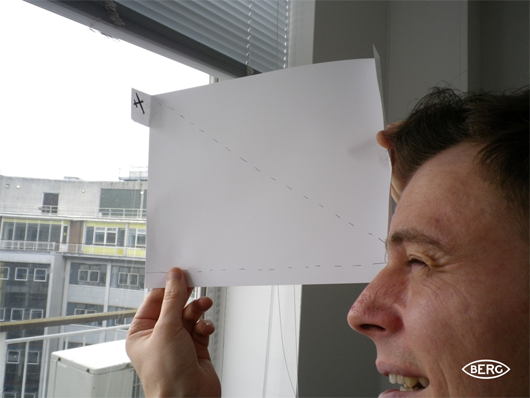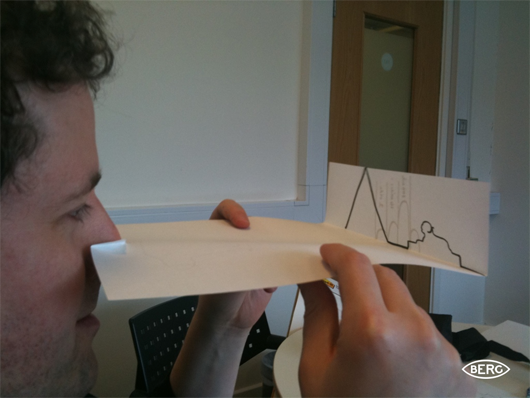PaperCamp 2 was on Saturday. It was ace.
PaperCamp is all about, well, paper. As the PaperCamp 1 wiki says,
“whether that’s looking at material possibilities of paper itself, connecting paper to the internet and vice-versa with things like 2d-barcodes, RFIDs or exotic things like printing with conductive inks… it’s about the fact that paper hasn’t gone away in the digital age – it’s become more useful, more abundant and in some cases gone and got itself bionic superpowers.”
Roo and Ben have done a couple of lovely write-ups. As Ben said, “Stuff is happening at the moment that I feel we’ll look back upon and enjoy saying, I was there. Papercamp was one of those.”
Anyway, I rambled a bit about some things, and gave everyone a few behind-the-scenes glimpses of some ideas we’ve had around paper over the last few months at BERG, so I thought I’d share a few slides here. But first, here’s some stuff we like.
Making and thinking with paper
I remember doing tons of these Albers paper studies at school. You know, just lovely bits of material exploration. Finding the inherent properties of things. And there was loads of it going on throughout the day on Saturday.

Cutting and folding paper is a common way of exploring the material of other ideas too. Say, mathematics. There must be something in the crossover of immaterial and material, and the ease and immediacy of making as thinking. Say, people like Gerry Stormer, who makes gorgeous “Origamic Architecture”…

… and David Huffman (the same David Huffman that invented Huffman encoding), who is really into curved folds.

And then of course, there’s this magical self-folding origami that came out of MIT and Harvard a few months back. It’s clumsy but mind-blowing. During the talk, we were told by Ben that it works because “it’s covered in stuff”.
Paper and data and storytelling
Seeing as we’re reading from screens more and more in our everyday lives, maybe the pressure might be off books and paper as things that need to impart information. They’re being freed up as something we can do new things with. And, of course, the web has given us loads of new ways to feed information back on to (and into) paper itself.
It makes me think of things like Bruno Munari’s brilliant Look Into My Eyes…
…or the colossal Star Wars pop-up book by Matthew Reinhart, which I think would be loads better if it had no text.
What if we ignored printing altogether, and imagined what we could do with just data and paper? Datadecs (by our mates RIG and Andy Huntington) looks at this idea in a typically charming way (OK, they’re not made of paper, but you know).

And Nick O’ Leary’s Paper Graphs point at some similar loveliness. Now I’ve got my christmas decorations, I want data-driven presents under the tree too.
Then there are the projects that take the best bits of everything: the web; printing; paper; maps; context of use and so on. James Bridle’s A Wide Arm Of Sea is a fully immersive, locative, pervasive, contextually-aware, haptic, 3D augmented reality experience. All printed on a bit of newspaper.

Some recent BERGian papery thinking
We’ve been dancing with a few ideas around paper here at BERG in a few recent projects too. They haven’t made it into the world (yet, maybe), but we thought that they’d be worth sharing.
One idea that didn’t make it past the drawing board for BBC Dimensions was Post-Digital Printed Augmented Reality. Or, Sticking A Bit Of Paper In Front Of Your Face.
If we knew, say, the height of the Saturn V rocket; roughly what height you are, and how far away the horizon is, maybe we could make a paper sextant to help you imagine where the tip of the rocket would be if it were in front of you.

Or how about how the silhouette of a Spitfire if it was zooming over you, x distance away at x altitude?



Or how about how big the Great Pyramid of Giza would be if it was on the horizon?


I know, I know. But it could totally work!
Also, here are some of the experiments around the cut-out-and-keep schools we did for Schooloscope back in July. We already had all the parameters in place to draw a picture of a school on the site, so why not use the same variables to draw data-driven pop-up postcards, that fold up and lock together without needing glue? We didn’t get time to look at this in as much detail as we’d hoped to at the time, but it’s there in the idea drawer.





Getting the fold to lock into place nicely was important – the thinking being that this could be a little souvenir that could sit nicely on a desk or wherever. You can imagine the little school sitting on a road, maybe with the sky painted in behind, or pointing to other schools nearby, and so on. We think there’s something really exciting in combining dry datasets with the graphic language of cereal boxes, or Pokemon cards or whatever.

Anyway. I told you this would be a bit of a ramble. Hopefully it points at bigger, cleverer, juicier things happening around paper and the web. I can’t wait to see what else pops up (sorry) over the coming months.


6 Comments and Trackbacks
1. Toby said on 11 October 2010...
I took lots of photos and put them on Flickr – http://www.flickr.com/photos/tobybarnes/sets/72157625134691052/with/5068925656/
2. tamberg said on 12 October 2010...
Loosely related: Paper is not dead. Books, magazines and other printed materials can now be connected to the digital world, enriched with additional content and even transformed into interactive interfaces. Conversely, some of the screen-based interfaces we currently use to interact with digital data could benefit from being paper-based or make use of specially designed material as light and flexible as paper. In a near future, printed documents could become new ubiquitous interfaces for our everyday interactions with digital information. This is the dawn of paper computing. – http://www.papercomp.org/
3. Jaf said on 19 December 2010...
I think this presentation that i’ve conducted about augmented reality and how much it’s influencing our daily life can be helpful. check it out.
http://www.jaftalks.com/Home/Show/intro-to-augmented-reality
Trackback: More Paper Graphs « knolleary 23 October 2010
[…] during the day, it was the opening one from Matt Brown of BERG that chimed the most with me. His write-up is worth a read. The Origamic Architecture by Gerry Stormer reminded me of the books my parents had […]
Trackback: More Paper Graphs | SoTech 23 October 2010
[…] of talks during the day, it was the opening one from Matt Brown that chimed the most with me. His write-up is worth a read. The Origamic Architecture by Gerry Stormer reminded me of the books my parents had […]
Trackback: Media Surfaces: The Journey – Blog – BERG 28 January 2011
[…] tiny, personalised, collectable paper-spimes provide a kind of papernet augmented-reality – giving a routine journey an extra layer of wonder and […]